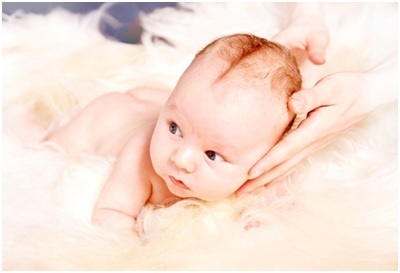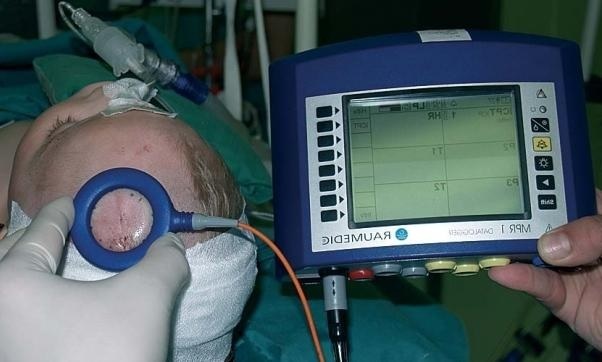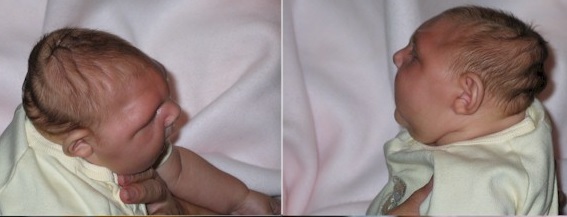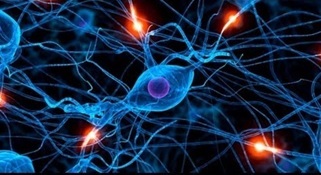Causes and manifestations of the cyst of the brain in infants
Contents:
- Etiological factors and classification of cysts
- Characteristic symptoms of the disease
- Methods of therapy of pathology
 The cyst in the head in neonates belongs to the neurological pathology. In the brain of the baby, cavities are formed, having clear boundaries and filled with liquid. Depending on the location, magnitude and timing of formation, various clinical manifestations are observed. Consider what triggers the emergence of cysts, possible treatments and predictions.
The cyst in the head in neonates belongs to the neurological pathology. In the brain of the baby, cavities are formed, having clear boundaries and filled with liquid. Depending on the location, magnitude and timing of formation, various clinical manifestations are observed. Consider what triggers the emergence of cysts, possible treatments and predictions.
Etiological factors and classification of cysts
The laying of organs in prenatal development belongs to the most responsible and most vulnerable period. In the development of the nervous system, cysts can sometimes be formed and absorbed, without any intervention. However, there are reasons for the cyst of the brain in newborns, indicating a violation of the development of the nervous system and requiring appropriate consultation and treatment:
- Infectious and sexually transmitted diseases of a woman during pregnancy. Their pathogens can penetrate the placenta and affect the brain tissue of the embryo, forming cysts after inflammatory processes.
- Traumatic brain injury during passage of the birth canal or after childbirth. The resulting intracranial hemorrhages and hematomas are transformed into cysts.
- The pathology of vessels supplying the brain leads to circulatory insufficiency, oxygen deficiency and nutrient connections. Brain cells die, and a cyst is formed.
- Inflammatory and infectious diseases of the brain( meningitis, encephalitis) in early infancy.
- Herpes virus affects brain cells.
Important! Regardless of the influencing factor, the free space after the death of( necrosis) of the brain tissue and the accumulation of cerebrospinal fluid form the cyst of the brain in the infant.
Classify cysts for localization in brain structures:
- arachnoid - outside the cyst, is located in the arachnoid shell, grows rapidly, but successfully treated;
- cerebral is located in the brain.
Distinguish the colloid form, which is formed during fetal development, leads to hydrocephalus and requires surgical treatment. The most benign is the epidermoid cyst. In the area of the epiphysis, a pineal cyst is identified, causing visual and coordination disorders, threatening the baby with hydrocephalus and inflammation of the tissues.
Characteristic symptoms of
The characteristics and severity of the clinical course depend on the size and location of the lesion. Having a small diameter and "safe" localization, it can exist asymptomatically. However, the cyst in the head of the infant shows attention with the basic symptoms:
- there is a constant regurgitation in sufficient quantity, which is associated with increased intracranial pressure;
- baby refuses to breast, begins to lose weight;
- manifests a lag in physical and psycho-emotional development;
- the child is restless, does not sleep well, cries, experiencing significant headaches;
- can bulge and pulsate a fontanel;
- marked seizures and tremor( tremor) of the limbs;
- coordination of movements is violated.
If the congenital cyst of the brain is located in the back of the head, the baby has visual impairment. Disorders of the formation of speech skills and motor coordination will prompt a search for a problem in the cerebellum. Neoplasm at the base of the skull or temples is manifested by abnormalities in mental development and hearing impairment, respectively.
To suspect the presence of the cyst of the brain in the infant and pressure on the ventricles of the brain will help clear manifestations and the growth of neurological symptoms:
- characteristic vomiting "fountain" and constant crying of the baby;
- significant intracranial pressure leads to the fact that the seams of the skull diverge, the fontanel bulges out and does not overgrow in time;
- observed tremor of extremities and hypertension of muscles;
- pain sensitivity decreases.
Important! It is recommended to closely monitor the development of the baby, especially in the troubled pregnancy and childbirth. The appearance of pathological neurological manifestations in the first months after birth is regarded as a signal for medical consultation, ultrasound and brain MRI.
Methods of therapy of pathology
 Treatment of a brain cyst in a child is divided into a conservative and surgical, depending on the severity of the course of the disease. With a small diameter of the neoplasm, lack of discomfort for the child and slow growth of the cyst, medicamental therapy is used. Its task is to improve blood circulation and immunity, fight viruses and stimulate the brain.
Treatment of a brain cyst in a child is divided into a conservative and surgical, depending on the severity of the course of the disease. With a small diameter of the neoplasm, lack of discomfort for the child and slow growth of the cyst, medicamental therapy is used. Its task is to improve blood circulation and immunity, fight viruses and stimulate the brain.
Surgery is indicated for large sizes that cause increased intracranial pressure or hydrocephalus. Bridging is carried out for the outflow of excess cerebral fluid. The method has a disadvantage - the possibility of infection and the occurrence of inflammation of the brain.
Another method is a puncture of the cyst by an endoscope and removal of the fluid. It is less dangerous, but, like the previous method, there is a restriction, they do not remove the wall of the cyst, leaving room for relapse. In some cases, an open operation is performed on the brain with trepanation of the skull.
Prognosis favorable for life and adequate development of the baby with timely diagnosis and treatment. The cysts that are started up are threatened with infection, inflammation of the brain tissue and the preservation of neurological symptoms.
write the question in the form below:



